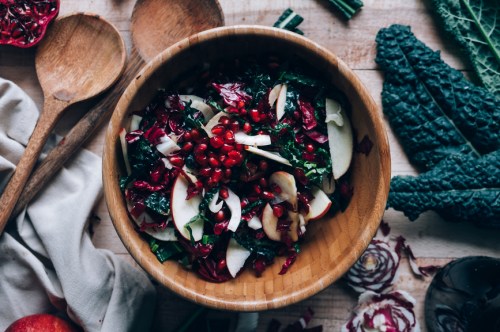When it comes to nutritional powerhouses, kale is among the most contentious ones of the dark leafy bunch. Some people absolutely love it, while others avoid it at all costs—and I’m an active, dedicated member of the kale fan club. It’s always my green of choice when building a salad, and I’ll typically buy a different type of kale than I did the last just to mix things up. But lately, à la Carrie Bradshaw, I couldn’t help but wonder: Are different types of kale identical from a nutritional standpoint, or do their nutrients vary from one kind to the next?
Experts in This Article
registered dietitian and plant-based chef based in St. Louis, MO
In search of clarity, I ended up getting a master class in all things kale from Alexandra Caspero, MA, RD, the owner of Delish Knowledge and an expert in plant-based eating.
Why kale is a nutritional powerhouse
Caspero begins by saying that while she’s not a fan of the term “superfood,” kale rightly earns this designation since 100 grams of this good-for-you green packs:
- 254 mg of calcium (almost as much as a glass of milk)
- 95 mg of vitamin C
- 1.6 mg of iron
- 348 mg of potassium
“Kale also provides carotenoids, antioxidants (like lutein, for eye health), vitamin E, vitamin K, and more,” Caspero continues. While she doesn’t count calories or suggest that clients do either, she calls kale “the perfect example of a nutrient-dense food” since it includes all of these micronutrients—plus four grams of gut-friendly fiber—at just 43 calories per serving.
Popular types of kale
There are many different types of kale to choose from, and hopefully you’ll have access to different varieties wherever you shop for your greens. In case you’re new to kale or need some help deciphering which ones may be best for your palate or a given recipe, Caspero has you covered.
1. Curly kale
When we think of kale (and we all do, right?), curly kale will likely be the first that comes to mind since it’s the type most commonly found in grocery stores. Caspero prefers to cook with this variety, or will otherwise finely chop it before adding to a salad. If you don’t love kale as much as I do, you’ll want to heed her insights. “As kale and other cruciferous vegetables can taste bitter, the more finely it’s cut and the less chewing you need to do, the more palatable it is for people who are still learning to like kale,” Caspero explains. “Adding a bit of salt—or salty flavors, like parmesan cheese—will also reduce its bitter compounds.”
2. Dinosaur kale
Next up is dinosaur kale (aka Tuscan kale or lacinato kale), which is characterized by its dark green pigment, narrow leaves, and bumpy texture that resembles dinosaur skin; it also tends to be a bit sweeter than curly kale. True to its other moniker, you’re likely to find it in Tuscan dishes that call for this dark leafy green, whether raw or cooked. “Dinosaur kale is my absolute favorite kind of kale,” Caspero says. “I like to remove the stem then thinly slice the kale into ribbons for salads, soups, or stir-frys.”
3. Baby kale
Often found in prepared salad packs, baby kale has small leaves and is versatile. “It’s fairly tender and great for salads or smoothies,” Caspero notes. You can also add it to sandwiches for an easy way to boost your micronutrient intake.
4. Redbor kale
My personal favorite is redbor kale, which you can identify by its deep purple/magenta hue; it also tends to be more mild in flavor. Caspero mentions that redbor kale—as well as Russian kale, which has purple/red stems and green leaves—can really be used in any recipe. Given their unique colors, these types of kale “can be a fun addition to salads or make for good kale chips,” she adds.
So do different types of kale provide different types or amounts of nutrients?
As far as my initial question goes, Caspero shares that kale will generally pack the same nutrients across the board, with only a few slight variations of note. “Most kale is the same nutrient-wise, but the various colors in the kale leaves—whether that’s a darker green or purple—will affect the various antioxidant levels” she explains. For instance, Caspero shares that purple kale offers a higher concentration of carotenoids and anthocyanins, the latter of which provides its deep hue as well as “antidiabetic, anticancer, anti-inflammatory, antimicrobial, and anti-obesity effects, as well as prevention of cardiovascular diseases,” per a 2017 review in Food & Nutrition Research.
In addition, the nutrient content in kale—no matter which type you choose—may change if you choose to cook your greens. “Water-soluble nutrients are always degraded when heat is added, but there are techniques to limit nutrient loss,” Caspero continues. “For example, steaming retains more nutrients than boiling.” But, of course, you can always eat kale raw, too.
Yet at the end of the day, she says that these considerations are pretty minor. Above all, it’s important to get more nutrient-rich produce in your diet—and if that happens to be kale of any kind, prepared in any way, that’s great. “If you only love kale sauteed with garlic and a little olive oil, [it’s not a big deal if you] lose some nutrients compared to a raw kale salad,” Caspero concludes. “The vast majority of Americans—around 90 percent, according to the latest CDC data—don’t consume enough fruits and vegetables each day. The bottom line should always be to eat whatever types of vegetables you can and enjoy, including kale in whatever variety you like.” And just like that, my kale curiosity was put to rest.
Sign Up for Our Daily Newsletter
Get all the latest in wellness, trends, food, fitness, beauty, and more delivered right to your inbox.
Got it, you've been added to our email list.










